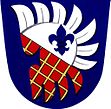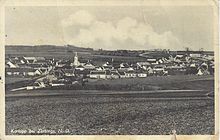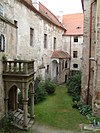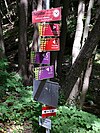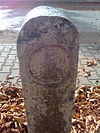Korolupy
| Korolupy | ||||
|---|---|---|---|---|
|
||||
| Basic data | ||||
| State : |
|
|||
| Region : | Jihomoravský kraj | |||
| District : | Znojmo | |||
| Area : | 1547 ha | |||
| Geographic location : | 48 ° 55 ' N , 15 ° 40' E | |||
| Height: | 433 m nm | |||
| Residents : | 156 (Jan 1, 2019) | |||
| Postal code : | 671 07 | |||
| structure | ||||
| Status: | local community | |||
| Districts: | 1 | |||
| administration | ||||
| Mayor : | Luboš Kyprý (as of 2014) | |||
| Address: | Korolupy 69 671 07 Uherčice u Znojma |
|||
| Municipality number: | 594253 | |||
| Website : | www.obec-korolupy.cz | |||
Korolupy (German Kurlupp) is a village with 168 inhabitants in Okres Znojmo in South Moravia , Czech Republic . It is located seven kilometers from the Vratěnín / Drosendorf border crossing with Austria.
etymology
At the end of the 13th century, when specialized craftsmen or agricultural production settled in the village, the place name Korolupy arose. This type of naming was often used in the Middle Ages. Place names with the old Czech possessive suffix -jъ were more likely to be retired at the end of the 13th century. It was a place where tree bark was peeled - "beef peeler".
Over the centuries there were various changes in the name of the place: 1372 Chirlobw, 1493 Chrlopy, 1571 Kurlup, 1869 Chrlopí (Znojmo district), 1880–1890 Chrlopy (Znojmo district), 1900–1910 Chrlopy (Moravské Budějovice district), 1921–1938 Korolupy, German Kurlupp (Moravské Budějovice district), 1938–1945 Kurlupp (Gau Niederdonau, Horn), 1945–1961 Korolupy (Moravské Budějovice district, after 1961 Znojmo district).
geography
The village is located on a plateau at an altitude of 433 meters near a small hill Kopka ( German Kuppen ) and on the right bank of the Blatnice river. Not only the location of the village in the west of the Znojmo district in the southwestern part of the South Moravian Region and on the border of the Jindřichův Hradec (Jihomoravský kraj), Třebíč (Vysočina) and Austria regions had a decisive influence on the historical development of the village. The isolated location from the large urban centers also had an impact on the population's agricultural and forestry activities.
Neighboring communities
| Lubnice ( Hafnerluden ) | Police u Jemnice ( Pulitz ) | Vysočany ( Wissokein ) |
| Mešovice ( Nespitz ) |

|
Oslnovice ( Höslowitz ) |
| Vratěnín ( Fratting ) | Uherčice ( Ungarschitz ) Drosendorf | Podhradí nad Dyjí ( Free Stone ) Drosendorf |
history
The history of the village of Kurlupp is closely related to the emergence of Lubnice ( German Hafnerluden ). The area around the confluence of the Austrian and Bohemian Thaja was already in the IX. Century owned by the German Empire and formed a border mark against Bohemia as well as against Moravia. The Raabs and Drosendorf castles were commissioned with this border guard . Another castle, which since the beginning of the XII. Century with Raabs, Drosendorf and other festivals on the Thaya in close connection, Pernegg was near Horn , where the gentlemen, later Counts of Pernegg, relatives of the Babenbergs, had their residence.
After the extinction of the Babenbergs the faithful servant Boczko was in 1252 by the new Duke Austria Ottokar II. Appointed head of the administration of the rule of good in the county Pernegg. The number of parishes, which were incorporated into the Premonstratensian , increased by the church in Fratting , when Wichard von Thürnau (de Tyrna) handed over his patronage and bestowal rights including the church in Fratting to the monastery for perpetual times so that the brothers there in fear of God could Loyally and diligently nurturing and cultivating worship services. The wording of the deed of donation shows that Wichard von Thürnau was wealthy in nearby Moravia, either through purchase or rather through marriage, since Moravian aristocrats are also mentioned among the witnesses, e.g. B. Wernhard von Butsch and his brother Ulrich and Gaytmar de Freistein. The Lords of Freistein had the same coat of arms as the Thürnau and were therefore probably closely related to them.
The first news about the castle "Vreynsteyne" on the Thaya comes from the year 1250 , which was owned by the brothers Gaytmar and Hartleb von Freistein. In 1331 the castle came into the possession of Konrad von Vöttau together with the village of Lubnice (including other villages) . The village of Korolupy was first mentioned in a document on October 28, 1372 as "villa Chirlobw", because the knight Seifried von Hafnerluden and his wife Bohuslawa (Lichtenburg?) Built a chapel in Hafnerluden, St. George and St. Dedicated to Katharina and donated a St. Peter's altar to Fratting .
The village of Korolupy was laid out as a Rundling , which suggests that it was founded under German law by the knight Seifrid von Plank ( von Hafnerluden ) with a predominantly Slavic population. The village of Lubnice had long been under the rule of Freistein . The Ui dialect (Bavarian-Austrian) that was spoken until 1945 and the old field names indicate an assimilation of the Czech population with the German population.
Gregor Wolny described the village of Korolupy as a village Kurlupp (Chrlopy) and 1 mill with a board saw on the Klampfnerbach in Vöttau, with its own school and a parish church Skt. Laurenzkapelle , built in 1798 , in which masses are read on certain days of the year. The place, which contained 1 farm in the 15th century and which was also exempted from the obligation to seize in 1561 , was, like so many others in this area, in prehistory, according to the language, entirely Moravian, and it was not until 1832 that the last farmer who spoke in this way died in the 95th year of life. Two residents belong to the domin. Vöttau.
Collalto et San Salvatore
After the First World War, the multi-ethnic state Austria-Hungary disintegrated and the place became part of Czechoslovakia.
| After a very frequent change of land and feudal rule, the rule of Ungarschitz and with it the village of Korolupy came in 1769 to the count and later dynasty of Collalto et San Salvatore. After the establishment of the First Republic, the Neu-Ungarschitz, Mitrowitz farms, the distillery, the lime kiln and the Neu-Ungarschitz power station remained exempt from confiscation. The forestry and the ruins of Freistein were nationalized. The rest of the Kurlupp estate was sold to the Moravian-Silesian region and then to a Czech family. The remainder of the Gösingshof was rebuilt, the Neuhof remained confiscated. For the population, mostly active in agriculture, the rulers (Prince Collalto) set up the workers' house for the destitute workers. | |
|
|
|
Agriculture, trade until 1945
The population lived primarily from growing grain. Peas, lentils, vetches and clover were also grown. Other important areas were livestock farming (543 cattle and 224 pigs around 1910) and forest work (563 hectares around 1900). Sawmill and brick kiln, a water-powered mill and two restaurants with a bowling alley. Later an inn with a grocery store was set up. Otherwise still small businesses and small house owners.
Institutions and associations until 1938
- 1770 German elementary school (1891 new buildings, one-class, later two-class, 1939 also kindergarten)
- 1798 Church of St. Laurentius
- 1806 cemetery
- 1857 rectory
- 1886 German School Association for Fratting and the surrounding area (from 1910 under the Ungarschitz local group)
- 1893 Kurlupp volunteer fire brigade (8th district of Znojmo , then XXIIIth district of Frain )
- 1899 Confederation of the Germans of South Moravia for the Fratting-Ungarschitz area
- 1903 Agricultural Association Fratting and the surrounding area
- 1903 Savings and Loan Association for Kurlupp (later Raiffeisenkasse )
- Responsible post office in Fratting, later in Ungarschitz , from January 1st 1906 an Imperial and Royal Kurlupp post office
- 1912 Kurlupp milk cooperative
- Kastanienallee on the village square
- 1921 Czech elementary school
- 1928 Grain cleaning station
- 1930 Local group Národní jednota pro jihozápadní Moravu
- Fire station with dance hall and stage
- German community library
- Two poor houses
- Warehouse and warehouse cooperative
- 1936 electrification
| 1938–1945 THIRD REICH GAU NIEDERDONAU 141 | |
|---|---|
| MUNICIPALITY 15 - Kurlupp village | LANDKREIS HORN |
| District Court | Frain - Vranov nad Dyjí |
| Post - filing | Ungarschitz - Uherčice |
| Registers | Fratting - Vratěnín |
| Gendarmerie | Fratting (1876-1939) |
| employment exchange | Znojmo - Znojmo |
| surface | 1 587 ha |
| Houses | 85 (1942) |
| population | 407 of which 202 M (1942) |
| Farms | 76 (1942) |
In 1939 a dairy cooperative was founded, which collected milk from 78 villages and a catchment area of 900 square kilometers. The architects Ernst Otto Hofmann and Adolf Hoch took on the planning of a new attached cheese dairy . On May 8, 1942 , the building in Langau was put into operation. The catchment area ranged from Theras to Kurlupp and from Großau to Retz . Up to 20,000 liters of milk per year were processed into Tilsit cheese in the cheese factory . The whey produced was used to produce alcohol, fruit juices and other products, along with up to 180 tons of butter.
Expulsion 1945/46
On June 9, 1945 , the first Czech “partisans” came to town by truck. The German residents of Kurlupp were ordered to gather at the church within an hour. Now they have been driven across the border into Austria by their Czech guards. Czech partisans took control of the village. All books, musical instruments, radios, bicycles and much more had to be handed in. Then came the Czech squatters. They not only appropriated the house and yard, the German homeowners had to continue to do the work for them. The organized forced evacuation of the Germans took place in early 1946. All private and public property of the German local residents was confiscated by the Beneš decrees and the Catholic Church was expropriated during the communist era. The Czech Republic has not made amends .
communism
The expulsion of the German inhabitants became an essential prerequisite for the large-scale fortification of the western borders. In 1950, KSČ set up the Iron Curtain. It consisted of barbed wire, shooting orders, dog runs, watchtowers, self-firing systems, minefields and kilometers of restricted areas on the eastern side. The entire border was completely sealed off. The main aim was to prevent people from communist-ruled states from fleeing to Western Europe. As a result, many traffic routes to the west were barricaded and many of the once numerous border crossing points were closed. Even towns and buildings were demolished or blown up; many were abandoned or dilapidated. The Communist Party simply wasted a substantial part of the German property confiscated. In the 1950s, the rural intelligentsia and the private sector ruined, and socialization in the years to come showed itself through the cultural and spiritual decline of the village.
seal
When King Wladislaw II confirmed various privileges to the Kurluppern in 1498, they did not include the right to use a seal. Kurlupp later carried a community seal that shows the Mother of God with the Infant Jesus standing between two flower stalks above the place name. Municipal stamp of the 20th century. carry a non-image legend. A coat of arms has the approx. Community with 400 inhabitants not managed. The registers have been kept since 1858 (before that from 1751 at Vöttau) and are now in the Brno State Archives.
Community structure
No districts are shown for the municipality of Korolupy. (Place names before 1945)
population

| year | population | Adults | Catholic | Houses |
|---|---|---|---|---|
| 1862 | 386 | k. A. | 386 | k. A. |
| 1874 | 390 | k. A. | 390 | 73 |
| 1900 | 413 | k. A. | 413 | 76 |
| 1910 | 404 | 334 | 404 | 77 |
| 1930 | 432 | 255 | 432 | 83 |
| 1938 | 443 | k. A. | k. A. | 83 |
Year 1938: 85% German, 15% Czech and 5 mixed marriages
Personalities
- Beer Augustin (* Kurlupp, † March 20, 1860 Waidhofen an der Ybbs ), Pastor Beer came from a local old miller family. Dean and Rector, (Deanery Waidhofen an der Ybbs of the Diocese of St. Pölten), donated a new school and parish (worth 6,000 guilders) to the Korolupy community in 1857.
- Johannes Heinrich Apeltauer (born December 27, 1873 Kurlupp, † February 10, 1914 Teplá Abbey ), Premonstratensian in Teplá Abbey.
- Leopold Scherer (*?, † Kurlupp), senior teacher, in 1877 Silver Cross of Merit with the Crown (Civil Cross of Merit was donated by Emperor Franz Joseph I and "as a reward for loyal and active, proven dependence on the emperor and fatherland, for many years, recognized more promising Use in the public service or other services earned for the general best ”).
- Petr Waněk (born June 29, 1845 Vanov u Telče , † May 16, 1928 Kurlupp), mill master and long-time mayor of Kurlupp.
- Franz Blažek (born April 8, 1857 Loukovice , † May 31, 1918 Kurlupp), learned tailor, businessman in Kurlupp and Ungarschitz , member of the municipal council in Kurlupp, founder and long-time commanding FF Kurlupp.
- Anton Pošvář (* Újezd near Mährisch Kromau , † August 23, 1924 Kurlupp), pastor in Kurlupp since 1907 and excurrendo in Hafnerluden since 1909 , chairman of the fire brigade and local school board.
- Ernest Körner (*?, † July 7, 1943 in Znojmo ), senior teacher in Kurlupp, the paymaster of the local group of the German School Association , member of the local group Bund der Deutschen , in the association of teachers and school friends and at the same time as an excellent custodian in the associations.
Emigration
The unemployment rate is among the highest in the entire republic. The emigration of young families in particular from the village is continuing. The infrastructure is not sufficiently developed and projects for sustainable development of the village were not accepted by the municipality in the years 2010-2014.
Village development
The landscape, spared from major industrial interventions, is the greatest potential of the village and also of the region. The forest shapes the landscape of the village, offers relaxation and is part of the village and cultural identity. Under Mayor Martin Hanek (1998–2010), the village community started to build a natural gas pipeline, a drinking water pipeline and a sewage disposal system (EU subsidy). With this, the village of Korolupy has created a sewer system, sewage treatment plant, drinking water pipeline, electricity pipeline and gas pipeline since 2015.
| The village is located in the microregions around Frain an der Thaya and Jamnitz. It is a rural area with no disruptive elements of modern civilization. | |

|
As part of the landscape program for the ecological stability of the area system, 9 bio-centers, 13 bio-corridors and 10 interaction elements were proposed in the village. Between Frain an der Thaya and Retz, the Thaya flows through a unique valley landscape. In order to preserve this breakthrough valley on the border with Austria in its original form, the Podyjí National Park was established. He works very closely with the Thayatal National Park. |
| One focus of regional development is primarily the expansion of soft tourism, which was mostly built up by individuals. Outside the place with cultural and historical sights in the area, there is the development of agrotourism. One advantage is the location of Korolupy on the border with Austria. | |
|
|
|
Attractions
|
|
Individual evidence
- ↑ Český statistický úřad - The population of the Czech municipalities as of January 1, 2019 (PDF; 7.4 MiB)
- ↑ As Kováry, Bednáry, Štítary, Vinaře u. a.
- ↑ Hamalčíková Petr, Bc.:Ústav germanistiky, nordistiky a nederlandistiky, Německý jazyk a literatura, German and Czech place names in comparison, Magisterská práce, 2010, German
- ^ Lub - bark , online
- ^ A b c Mayer Anton: sheets of the Association for Regional Studies of Lower Austria, new series, XXIX. 1895.
- ↑ Documents (1188-1992) 1372 X 28 (AT-StiAGe) in the European document archive Monasterium.net .
- ↑ a b c Gregor Wolny: "The Margraviate of Moravia", Znojmo District, Brno 1837
- ↑ Jašš Richard Mgr: Pokus o geografické vymezení německé iredenty v českých zemích na podzim roku 1918, disertační práce, Czech
- ↑ 30. výročí vydání církevních zákonů v Československu - publikace secretariátu pro věci církevní ministerstva kultury ČSR
- ^ Korolupy village chronicle
- ↑ Bludovsky, Z. a kolektiv: Lesní hospodářství v České republice. Hradec Králové: Lesy ČR, sp, 1998.
- ↑ Frodl Gerald / Blaschka, Walfried: The districts of Neubistritz and Zlabings from A – Z. Geislingen / Steige 2008.
- ↑ Státní okresní archive Znojmo, Obecná škola (německá) Korolupy, Školní kronika 1891-1944 (school chronicle). Village chronicle Kurlupp.
- ↑ a b c Archive Biskupství brněnského, Děkanský úřad Vranov nad Dyjí 1724–1989.
- ^ Znojmo weekly paper, November 27, 1886
- ↑ Österreichische Verbands-Feuerwehr-Zeitung, July 20, 1893.
- ^ Fratting, Znaimer Tagblatt, August 20, 1899.
- ↑ Fratting village chronicle
- ↑ Znaimer Wochenblatt, May 12, 1909, p. 4.
- ^ Znojmo daily newspaper, January 4, 1906.
- ↑ Znaimer Tagblatt, June 3, 1916, Art. Federation of Germans in South Moravia.
- ↑ a b c d e f g h Státní okresní archive Znojmo, archive obce Korolupy.
- ↑ Státní okresní archive Znojmo, Základní devítiletá škola, 1. – 5. postupný ročník, Korolupy, Školní kronika 1921-1958, 1959-1977, třídní výkazy 1923-1949.
- ^ Ostmark yearbook Niederdonau, 1942, str.
- ↑ Státní okresní archive Znojmo, Četnická stanice Vratěnín (1876-1939, 1946-1950), Památník četnické stanice.
- ↑ Langau village chronicle
- ^ Arburg, Adrian: Migration Processes in Czechoslovakia. The expulsion of the Germans and their domestic consequences 1945–1950, Munich 2007 (1st and 2nd edition; publications by the Collegium Carolinum, 111)
- ↑ Iron curtain
- ↑ Bruno Kaukal: The coats of arms and seals of the South Moravian communities, Geislingen, therein a) ZDB VI / 14, XVI / 46 u. a .; St. Archives (Prague) VI / 574; b) Vrbka: Heimatkunde des polit. Bez. Znaim (1898) p. 13; S 05/137; SM 1952 / 175,413; E. Polly Zlabings and the Zlabingser Ländchen (Rottweil 1988) p. 38;
- ^ Pastor of Waidhofen
- ^ Wolny, Gregor: Church topography of Moravia mostly based on documents and manuscripts, Brno, self-published by the author 1855–1866.
- ↑ Pilsener Tagblatt, February 15, 1914, p. 4.
- ↑ Matrika Korolupy 14025, str. 22nd
- ^ Welt Blatt, August 11, 1877.
- ^ Matrika obce Korolupy.
- ^ Parish registers of Korolupy and Grossau
- ^ A b Fromme's Austrian Fire Brigade Calendar, 1883–1921
- ↑ Korolupy registers 14026
- ↑ Znaimer Tagblatt, July 8, 1943, p. 4 - death.
- ^ Matrika Korolupy a Uherčice.
- ↑ a b c Program rozvoje cestovního ruchu v JMK pro roky 2007–2013
- ^ Municipality of Korolupy, municipality documentation and EU subsidy.
- ↑ http://foto.mapy.cz/346775-Korolupy-kostel
- ↑ http://foto.mapy.cz/133526-2007-III-Korolupy-mlyn
- ↑ http://foto.mapy.cz/346776-Kaplicka-u-Uhercic
- ↑ http://foto.mapy.cz/346774-Korolupy-nad-hrbitovem
- ↑ http://foto.mapy.cz/133840-2007-VII-Uhercice-stara-cihelna
literature
- Arburg, Adrian: Migration Processes in Czechoslovakia. The expulsion of the Germans and their domestic consequences 1945–1950, Munich 2007 (1st and 2nd edition; publications of the Collegium Carolinum, 111), pp. 241–284.
- Arburg, Adrian von: Kdo byl německým antifašistou? / Who was a German antifascist? in: Okurka, Tomáš (ed.): Zapomenutí hrdinové: Němečtí odpůrci nacismu v českých zemích / Forgotten Heroes: German Nazi opponents in the Bohemian countries. Ústí nad Labem (Aussig) 2008, pp. 9–24.
- Bahlcke, Joachim / Eberhard, Winfried / Polívka, Miloslav: Handbook of historical sites. Bohemia and Moravia, September 1998.
- Bartoš, Josef / Schulz, Jindřich / Trapl, Miloš: Historický místopis Moravy a Slezska v letech 1848–1960, 9: Okresy Znojmo, Moravský Krumlov, Hustopeče, Mikulov, 12: Okresy: Třebíč, Moravské Budějovice, Dačějovice, Ostrava 1966.
- Berwid-Buquoy, Jan: Integration and separation of the Sudeten Germans in the ČSR 1918–1920. Theories of Nationalisms (dissertation), České Budějovice (Budweis) 2005.
- Blaschka, Walfried: Historical Directory of South Moravia, in: Contributions to the history and regional studies of South Moravia, Issue 8, Geislingen / Steige 1982.
- Bornemann, Felix: Arts and Crafts in South Moravia, Geislingen / Steige 1990.
- Bornemann Hellmut: Land on the Thaya.
- Bornemann Hellmut: Znaim. City on the Thaya. Living past, Vienna 2007. Brandes, Detlef: The way to expulsion 1938–1945: Plans and decisions for the transfer of Germans from Czechoslovakia and Poland, Munich 2001 (publication of the Collegium Carolinum, vol. 94).
- Elsinger, Reiner: Expulsion of the Germans from South Moravia.
- Frodl, Gerald / Blaschka, Walfried: The districts of Neubistritz and Zlabings from A – Z. Geislingen / Steige 2008.
- Frodl, Gerald / Blaschka, Walfried: The Znaim district from A – Z. Geislingen / Steige 2010.
- Hrabcová Lucie: Organizace veřejné správy v období první republiky (s přihlédnutím k Organizaci veřejné správy v politickém okrese Hustopeče) - Diplomová práce, Brno 2006.
- Jašš, Richard Mgr: Pokus o geografické vymezení německé iredenty v českých zemích na podzim roku 1918, disertační práce.
- Kaukal, Bruno: The coats of arms and seals of the South Moravian communities, Geislingen / Steige 1992.
- Kleindienst, Leopold: The forms of settlement, rural building and material culture in South Moravia, 1989.
- Kreuzer, Anton / Frodl, Gerald / Schickel, Alfred: History of South Moravia, 3 volumes, Geislingen / Steige 1975, 1996 and 2001.
- Kronika obce Korolupy
- Lange, Fritz: South Moravia. Pictures tell history, Erfurt 2010.
- Lederer, Hans: The Germanic Settlement of South Moravia, in: Contributions to the history and regional studies of South Moravia, Issue 9, Geislingen / Steige 1986.
- Old Austrian reading book
- Mnichovská dohoda a osud sudetských Němců (kolektiv autorů, překlad P. Kamas), guidemedia Brno 2012, ISBN 978-80-905310-0-0 , Vazba: brožovaná, počet stran: 160, Rozměry: 240 × 170
- Papírník, Miloš: Bibliography okresu Znojmo. Brno 1992.
- Prince, Friedrich: Bohemia and Moravia. Siedler, Berlin 1993.
- Prokůpek, Bohumír; Prokop, Paul u. a .: Jižní Morava. Příroda a Památky / South Moravia. Nature and monuments, Prague 1991.
- Schweickhardt, Franz: Representation of the Archduchy of Austria under the Enns. Quarter under the Manhartsberg. Vol. 1, 2, 7. 1833/35
- Seibt, Ferdinand: Germany and the Czechs. History of a neighborhood in the middle of Europe. 3rd updated edition. Piper, Munich / Zurich 1997.
- Staněk, Tomáš: Persecution 1945: The position of the Germans in Bohemia, Moravia and Silesia (outside the camps and prisons), Vienna / Cologne / Weimar 2002 (book series of the Institute for the Danube Region and Central Europe, 8, original: Perzekuce 1945, translation from the Czech).
- Staněk, Tomáš: Internment and forced labor. The storage system in the Bohemian countries 1945–1948, in: Publications of the Collegium Carolinum Volume 92. From the Czech by Eliska and Ralf Melville, Munich 2007.
- Tielsch-Felzmann, Ilse: South Moravian legends. Munich 1969. Vlastivěda moravská, Dil II: 27.
- Weisz, Franz / Elsinger, Reiner: The historical causes of the expulsion of the Germans from South Moravia 1945-1946 and the consequences under international law. A contemporary historical research project, Vienna 1996.
- Winkelbauer, Thomas: Contacts and Conflicts. Bohemia, Moravia and Austria. Aspects of a millennium shared history, Waidhofen ad Thaya 1993 (series of publications by the Waldviertler Heimatbund, vol. 36).
